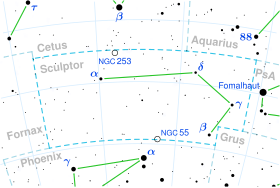
Summary
μ Sculptoris, Latinized as Mu Sculptoris, is a solitary,[11] orange-hued star in the southern constellation of Sculptor. It is visible to the naked eye as a dim point of light with an apparent visual magnitude of +5.30.[2] This star is located approximately 291 light years from the Sun based on parallax,[7] and it is drifting further away with a radial velocity of +16 km/s.[1]
| Observation data Epoch J2000 Equinox J2000 | |
|---|---|
| Constellation | Sculptor |
| Right ascension | 23h 40m 38.14898s[1] |
| Declination | −32° 04′ 23.2478″[1] |
| Apparent magnitude (V) | 5.30[2] (5.30 – 5.33)[3] |
| Characteristics | |
| Evolutionary stage | giant |
| Spectral type | K1 III[4] |
| U−B color index | +0.69[5] |
| B−V color index | +0.97[6] |
| Variable type | suspected[3] |
| Astrometry | |
| Radial velocity (Rv) | +15.79±0.12[1] km/s |
| Proper motion (μ) | RA: −91.30[7] mas/yr Dec.: −53.29[7] mas/yr |
| Parallax (π) | 11.6622 ± 0.1228 mas[1] |
| Distance | 280 ± 3 ly (85.7 ± 0.9 pc) |
| Absolute magnitude (MV) | 0.54[2] |
| Details | |
| Mass | 1.32[8] M☉ |
| Radius | 10.88+0.16 −0.13[1] R☉ |
| Luminosity | 61.4±0.8[1] L☉ |
| Surface gravity (log g) | 2.50[8] cgs |
| Temperature | 4,899+29 −35[1] K |
| Metallicity [Fe/H] | −0.21[2] dex |
| Rotational velocity (v sin i) | 2.6[9] km/s |
| Other designations | |
| Database references | |
| SIMBAD | data |
This object is an aging K-type giant star with a stellar classification of K1 III.[4] Having exhausted the supply of hydrogen at its core, this star expanded and cooled off the main sequence. At present it has 11[1] times the girth of the Sun. It is a suspected variable star of unknown type, with its brightness measured as varying from magnitude 5.30 down to 5.33.[3] The star has 1.32[8] times the mass of the Sun and is radiating 61[1] times the Sun's luminosity from its swollen photosphere at an effective temperature of 4899 K.[1]
References edit
- ^ a b c d e f g h i j k Brown, A. G. A.; et al. (Gaia collaboration) (August 2018). "Gaia Data Release 2: Summary of the contents and survey properties". Astronomy & Astrophysics. 616. A1. arXiv:1804.09365. Bibcode:2018A&A...616A...1G. doi:10.1051/0004-6361/201833051. Gaia DR2 record for this source at VizieR.
- ^ a b c d Anderson, E.; Francis, Ch. (2012). "XHIP: An extended hipparcos compilation". Astronomy Letters. 38 (5): 331. arXiv:1108.4971. Bibcode:2012AstL...38..331A. doi:10.1134/S1063773712050015. S2CID 119257644. Vizier catalog entry
- ^ a b c Samus, N. N.; et al. (2017). "General Catalogue of Variable Stars". Astronomy Reports. 5.1. 61 (1): 80–88. Bibcode:2017ARep...61...80S. doi:10.1134/S1063772917010085. S2CID 125853869.
- ^ a b Hoffleit, D.; Warren, W. H. (1995). "Bright Star Catalogue". VizieR On-line Data Catalog: V/50. Originally Published in: 1964BS....C......0H. 5050 (5th Revised ed.). Bibcode:1995yCat.5050....0H.
- ^ Mermilliod, J. C. (2006). "Homogeneous Means in the UBV System". VizieR On-line Data Catalog: II/168. Originally Published in: Institut d'Astronomie. 2168. Bibcode:2006yCat.2168....0M.Vizier catalog entry
- ^ Mallama, A. (2014). "Sloan Magnitudes for the Brightest Stars". The Journal of the American Association of Variable Star Observers. 42 (2): 443. Bibcode:2014JAVSO..42..443M.Vizier catalog entry
- ^ a b c Van Leeuwen, F. (2007). "Validation of the new Hipparcos reduction". Astronomy and Astrophysics. 474 (2): 653–664. arXiv:0708.1752. Bibcode:2007A&A...474..653V. doi:10.1051/0004-6361:20078357. S2CID 18759600. Vizier catalog entry
- ^ a b c Allende Prieto, C.; Lambert, D. L. (1999). "Fundamental parameters of nearby stars from the comparison with evolutionary calculations: Masses, radii and effective temperatures". Astronomy and Astrophysics. 352: 555–562. arXiv:astro-ph/9911002. Bibcode:1999A&A...352..555A. Vizier catalog entry
- ^ De Medeiros, J. R.; Alves, S.; Udry, S.; Andersen, J.; Nordström, B.; Mayor, M. (2014). "A catalog of rotational and radial velocities for evolved stars". Astronomy & Astrophysics. 561: A126. arXiv:1312.3474. Bibcode:2014A&A...561A.126D. doi:10.1051/0004-6361/201220762. S2CID 54046583. Vizier catalog entry
- ^ "mu Scl". SIMBAD. Centre de données astronomiques de Strasbourg.
- ^ Eggleton, P. P.; Tokovinin, A. A. (September 2008). "A catalogue of multiplicity among bright stellar systems". Monthly Notices of the Royal Astronomical Society. 389 (2): 869–879. arXiv:0806.2878. Bibcode:2008MNRAS.389..869E. doi:10.1111/j.1365-2966.2008.13596.x. S2CID 14878976.



